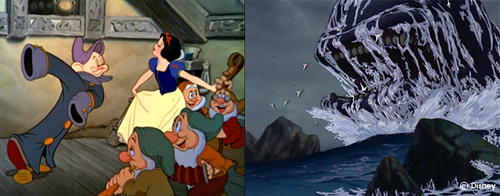I downloaded a program called “animation & drawing” on my ipad two hours ago
Tag: animation
I downloaded a program called “animation & drawing” on my ipad two hours ago
20 things you can expect as a traditional (2D) animation student that they never tell you:
- you will love your rough drawings more than your clean
- if you don’t flip your drawings your teachers will know. oh they will know.
- you will draw an insane amount of detail at first in hopes to impress your teachers. don’t. they’ll get you to inbetween that and it’s not fun. trust me, there’s a reason successful cartoon shows have nice, simple, clean designs.
- line weight is hella important. as is colour theory.
- storyboarding is not easy. it’s actually in demand rn because of how time consuming/difficult it is. lots of fun though especially if you’re a creative person.
- the animator’s survival kit is your bible. doesn’t matter that thing weighs as much as a small child. take that with you everywhere. it is now your baby.
- glen keane is considered a deity amongst animators.
- your teachers will likely look hella young but irl be much much older. this seems to be a side effect of working in kid’s shows for over 10 years. it is a good thing.
- every animator knows the impending dread of deadlines. yes, this includes your teachers. it is likely many of them will be working at studios/their own projects the same time as teaching. that is why they are immortal and their wisdom incomparable.
- speaking of deadlines, say goodbye to a regular sleeping pattern and balanced lifestyle
- if your wrist starts to ache like a then start drawing more with your shoulder. loosey goosey baby. loosey goosey.
- life drawing is essential. don’t skip that . anatomy is important. even if your character has six arms and five eyes you still need to be able to make them move.
- you are regarded as a dying breed amongst the 3d kids. that’s ok. give them a pencil and paper and ask them to animate a 4 legged walk cycle traditionally. see what happens.
- however if you’re anything like me, maya will look like a foreign language to you.
- srsly wtf is maya? what sacrifice to the animation gods must i make to understand this program?
- watching your favourite cartoons and animated movies regularly is important not only to motivate but is essential bonding time with your classmates. only now everyone wants to talk about how beautiful the backgrounds in steven universe are as well as cry over the character designs.
- perspective is hard. period.
- there is always that one kid in class who’s already done their 10,000 drawings and are untouchable. those are the ones to sit near in the hopes you can try and get some of that raw talent to rub off onto you.
- coffee/energy drinks/sugar will rise to the top of your already crumbling food pyramid.
- you improve lots. and some days something will just click and all of a sudden you’re firing out 40 frames an hour.
and finally no. 21 the most important thing of all: bring a blanket and something squishy to sleep on and leave them at school. there will be emergency nap times. sometimes weekly. sometimes daily.
Me when I studied Animation. Srsly all this!
the deadlines…
#21 Use the timing charts and X-Sheets, even if you do the notation after the fact. Your teachers will know and there will be hell to pay if you didn’t. Also, you need them for proper tiedowns and cleanup, and for anything with even a minimal level of complexity. You WILL forget what you were doing and you will need that notation to decipher your own work.
(#20 is both amazing and frustrating in how it comes and goes.)
While the Animator’s Survival Kit is an excellent resource and full of memorable advice and anecdotes, Eric Goldberg’s Character Animation Crash Course is short, streamlined, and and to the point. I say carry that one around and read Richard Williams’ book while at home.
Quickest way to improvement? Practice. It’s a simple bit of advice that rings with absolute truth. Articles, tips, mentors, and study will never get you as far as rolling up your sleeves and getting down to work, be it animation or any other skill. Today we’ve compiled a list of exercises, like animation push-ups, that will get your art skills buff and toned.
Maybe you still need convinced of how important the “Art of Doing” is? Look no further than the early days of animation, especially at the Disney studio. Here were a group of animators (before being an animator was even a thing) who HAD no books to read, or websites to visit, or even experienced animators to ask. They learned via the age old art of hands-on training, experimenting and discovering as they went. And some would argue they created some of the greatest animation to ever be seen. Masterpieces like the dwarfs dancing in Snow White or the terror of the Monstro scene in Pinocchio. So be like them! Get out there and do animation!
Some of these exercises you may have done or seen before; some maybe not. Consider doing each of them, even if you did once previously, because returning to an old exercise to see how much you’ve progressed is a very valuable experience.
Level 1 Exercises
(Do not discount their simplicity! Here you have the principals of animation, which all other animation is built on. They are worth your time and effort.)
- Ball Bouncing in place, no decay (loop)
- Ball Bouncing across the screen
- Brick falling from a shelf onto the ground
- Simple character head turn
- Character head turn with anticipation
- Character blinking
- Character thinking [tougher than it sounds!]
- Flour Sack waving (loop)
- Flour Sack jumping
- Flour Sack falling (loop or hitting the ground)
- Flour Sack kicking a ball
Level 2 Exercises
- Change in Character emotion (happy to sad, sad to angry, etc.)
- Character jumping over a gap
- Standing up (from a chair)
- Walk Cycle [oldie but goodie!]
- Character on a pogo stick (loop)
- Laughing
- Sneezing
- Reaching for an object on a shelf overhead
- Quick motion smear/blur
- Taking a deep breath [also tougher than it sounds!]
- A tree falling
- Character being hit by something simple (ball, brick, book)
- Run Cycle
Level 3 Exercises
- Close up of open hand closing into fist
- Close up of hand picking up a small object
- Character lifting a heavy object (with purpose!)
- Overlapping action (puffy hair, floppy ears, tail)
- Character painting
- Hammering a nail
- Stirring a soup pot and tasting from a spoon
- Character blowing up a balloon
- Character juggling (loop)
- Scared character peering around a corner
- Zipping up a jacket
- Licking and sealing an envelope
- Standing up (from the ground)
- Pressing an elevator button and waiting for it
- Starting to say something but unsure of how
Level 4 Exercises
- Character eating a cupcake
- Object falling into a body of water
- Two characters playing tug-of-war
- Character dealing a deck of cards out
- The full process of brushing one’s teeth
- A single piece of paper dropping through the air
- Run across screen with change in direction
- Sleeping character startled by alarm then returning to sleepy state
- Opening a cupboard and removing something inside
- Putting on a pair of pants
- Opening the “world’s best gift” and reacting
- Any of the above exercises using a very heavy character/object next to a very light character/object. Enhance the differences the weight change makes!
Things to keep in mind:
- Reading these exercises will do as much for you as reading about push-ups would do for your physical muscles: NOTHING. If you want the benefit, you must animate them. Take a deep breath and just do it.
- Do not forget the famous words of Ollie Johnston: “You’re not supposed to animate drawings [3D models]. You’re supposed to animate feelings.” If a character isn’t thinking, they aren’t alive, and the animation has failed.
- Keep it simple! There is no reason to over complicate any of these exercises. Going back to push-ups, would push-ups be harder if while doing them you also recited the Gettysburg Address? Yes. Would they be any more beneficial? No. Keep things nice and simple and clear.
- Do your best. There is no reason to do these exercises poorly. Give it your all. You don’t have to show anyone, these are for you. You owe it to yourself to try your very best. Something not quite right? Take the time to fix it.
- As always, have fun. Push ups are not fun. Animation is supposed to be. Be joyful in your work!
Have any questions about the exercises above? Leave a comment below and we’ll answer them the best we can! Someone else may be wondering the exact same thing, so you’ll help them too. Likewise if someone is looking for possible exercises, why not share a link to these and give them a hand?
Article featured on AnimatorIsland.com
[Source]
Article composed by J.K. RIKI
MARCH 18, 2013
Follow @AnimatorIsland on Twitter for more updates tips and tricks.
Once upon a time, I wanted to be an animator more than anything else in the world.
Once upon a time, I wanted to be an animator more than anything else in the world.
(btw this is Aaron and I no joke)
Free Advice: Pixar’s 22 Rules of Storytelling
Free Advice: Pixar’s 22 Rules of Storytelling
It’s funny—just yesterday I was thinking about looking for writing related material to post, since it’s an extremely important beginning step to animation, and just now my friend tagged me in a post on Facebook linking to this!
- #1: You admire a character for trying more than for their successes.
- #2: You gotta keep in mind what’s interesting to you as an audience, not what’s fun to do as a writer. They can be v. different.
- #3: Trying for theme is important, but you won’t see what the story is actually about til you’re at the end of it. Now rewrite.
- #4: Once upon a time there was ___. Every day, ___. One day ___. Because of that, ___. Because of that, ___. Until finally ___.
- #5: Simplify. Focus. Combine characters. Hop over detours. You’ll feel like you’re losing valuable stuff but it sets you free.
- #6: What is your character good at, comfortable with? Throw the polar opposite at them. Challenge them. How do they deal?
- #7: Come up with your ending before you figure out your middle. Seriously. Endings are hard, get yours working up front.
- #8: Finish your story, let go even if it’s not perfect. In an ideal world you have both, but move on. Do better next time.
- #9: When you’re stuck, make a list of what WOULDN’T happen next. Lots of times the material to get you unstuck will show up.
- #10: Pull apart the stories you like. What you like in them is a part of you; you’ve got to recognize it before you can use it.
- #11: Putting it on paper lets you start fixing it. If it stays in your head, a perfect idea, you’ll never share it with anyone.
- #12: Discount the 1st thing that comes to mind. And the 2nd, 3rd, 4th, 5th – get the obvious out of the way. Surprise yourself.
- #13: Give your characters opinions. Passive/malleable might seem likable to you as you write, but it’s poison to the audience.
- #14: Why must you tell THIS story? What’s the belief burning within you that your story feeds off of? That’s the heart of it.
- #15: If you were your character, in this situation, how would you feel? Honesty lends credibility to unbelievable situations.
- #16: What are the stakes? Give us reason to root for the character. What happens if they don’t succeed? Stack the odds against.
- #17: No work is ever wasted. If it’s not working, let go and move on – it’ll come back around to be useful later.
- #18: You have to know yourself: the difference between doing your best & fussing. Story is testing, not refining.
- #19: Coincidences to get characters into trouble are great; coincidences to get them out of it are cheating.
- #20: Exercise: take the building blocks of a movie you dislike. How d’you rearrange them into what you DO like?
- #21: You gotta identify with your situation/characters, can’t just write ‘cool’. What would make YOU act that way?
- #22: What’s the essence of your story? Most economical telling of it? If you know that, you can build out from there.
“I will now explain why I am always right.”
I bet you guys are wondering why I ever quit animation, huh?!?! 😉
“I will now explain why I am always right.”
I bet you guys are wondering why I ever quit animation, huh?!?! 😉






